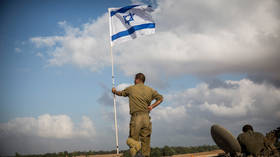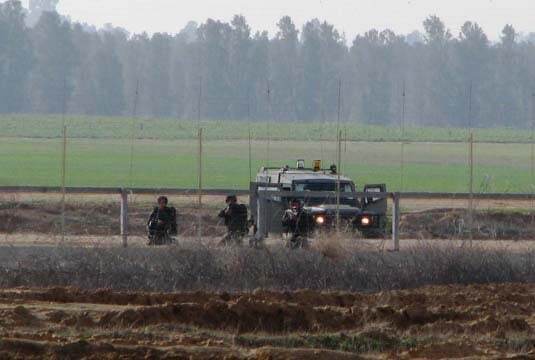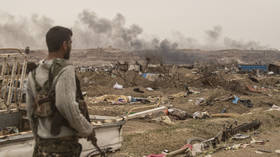The act of theatre that shows Israel’s contempt for Gaza

Israel has apparently reprimanded a soldier for firing rounds into Gaza. That’s all very well, but what about the countless other soldiers who have done the same for years, maiming and killing Palestinian civilians?
The soldier, who posted his bravado video to TikTok, reportedly got 10 days in military prison. According to an Israeli army statement, “The soldier’s behavior in the video does not conform with the norms expected of soldiers and commanders.”
His sentencing and the media reporting around the incident is pure theatre, given the reality of how the Israeli army routinely targets Palestinians working on land in Gaza’s east and northern regions. While this one particular soldier received a mild punishment, many others who attack unarmed civilians are not held accountable.
Since pulling the illegal settlers out of Gaza in 2005, Israel has implemented a kill zone – dubbed the “buffer zone” or “no go zone” – where, on a regular basis, its soldiers shoot at Palestinian civilians. Ostensibly, it comprises a band of land 300 metres from the fence encaging Palestinians in Gaza. In reality, Israeli soldiers fire upon civilians well over a kilometre away, or even further, as I have experienced myself.
As I reported some years ago, “According to the United Nations’ Office for the Coordination of Humanitarian Affairs (OCHA), the 300 metres off-limits area extends in areas to at least 1.5 km. PCHR [the Palestinian Centre for Human Rights] has documented the Israeli army targeting of Palestinian civilians as far as 2 km from the border.”

Between 2008 and 2013, I regularly accompanied farmers and other civilians in border areas, and on many of the occasions that we came under fire, we were 500 metres or more from the fence. Among the disturbing incidents was an attack one morning in February 2009, when I came under prolonged Israeli gunfire while accompanying a group of farm labourers on land roughly 500 metres from the fence. By then, I was accustomed to the routine – I would walk with farmers on their land, the Israeli soldiers would arrive in jeeps, assume sniper position and begin firing at us.
On this occasion, the young men had finished their parsley harvest and were pushing a stalled pickup truck when the Israeli gunfire began. The incident was captured on video, as I was there to document such attacks, and as I wrote at the time, “The lightly-dressed, unarmed farmers were clearly visible to… the several Israeli army jeeps and the Hummer which had patrolled the border fence, stopping for long intervals to watch the farmers work, then moving on.” I noted that the soldiers had observed us for a good half hour before shooting, choosing to fire at precisely the time when the farmers were leaving.
Shooting just beyond where I stood in a fluorescent vest, an Israeli soldier hit 20-year-old Mohammad al-Buraim in his leg, and continued to fire at us for a further 15 minutes. Some weeks prior, an Israeli soldier shot his cousin Anwar in the neck, killing him and leaving his wife, young children, and extended family without a breadwinner. Anwar had been on land 600 metres from the fence, also doing farm labour work.
When someone gets injured in these areas, the injury is compounded by the fact that ambulances cannot reach them, as they are targeted by the Israeli army. So, locals need to somehow get the injured to a point where an ambulance can safely reach them. If this is not done quickly enough, the injured risks bleeding to death.
On another occasion, again with farm workers in Gaza's southeast, I came under intense Israeli fire lasting over 40 minutes from soldiers roughly 500 metres away. Bullets flew within metres of our hands, heads, and bodies. This proved to be an especially interesting case, as a representative from the Canadian embassy in Tel Aviv – who had been informed of the shooting by other volunteers – called me to express concern for my safety.
This dissipated as soon as she realized I was being fired on by an Israeli soldier, and not a Palestinian. Her superior, the then-attache in the Tel Aviv office, had the gall to state quite clearly that they were fine with Israel’s “security measures” – firing on an unarmed Canadian and unarmed Palestinians and internationals, who in no way posed any threat to the heavily armed Israeli soldiers – and that we should be aware of the risks.
In another example, in February 2009, also in the southeast on land 550 metres from the fence, I accompanied elderly farmers and their families who intended to harvest some of their meagre crops. Shortly after we had arrived on the land, Israeli soldiers started firing very close to us, less than a metre from where we stood.
As I wrote at the time, “We could almost taste Tuesday’s firing, and the distinct ping-whizz sound they make was somehow impossibly loud, so close the shots were. One of the older women was having trouble walking away, stumbling in her fear. As the shots dug in around her she fell to the ground in terror. Positioning ourselves between the elderly farmers and the Israeli snipers, we accompanied them off the field. A few hundred metres away, the Israeli snipers continued to shoot. Another elderly woman had dived in terror behind a rock and adamantly wouldn’t get up. “They’ll kill me, they’ll kill me,” she cried in fear...”
Thankfully we did make it away that day in one piece. But this was just one of many examples of the terror Palestinian farmers face on a daily basis. And it’s not just farmers – at around the same time, a 17-year-old girl standing around 800 metres from the fence, near the ruins of her home (destroyed in the war just a month previously), was shot in the kneecap by an Israeli sniper.
Children going to school in the eastern village of Khoza’a were, at the time, being fired upon by Israeli soldiers at the fence 1km away. Teens and young men gathering scrap metal from demolished homes routinely come under Israeli fire. One example was 15-year-old Said Abdel Aziz Hamdan, who went to an area in Gaza’s north with his 13-year-old brother, to try to earn money for their large family. After finishing his work, an Israeli soldier fired at him, hitting his leg, without warning.
“People go there every day to gather bits of metal and concrete. The Israelis see us and know we are just working, it’s normal,” he told me when I visited him in hospital.
Palestinians don’t only face Israeli sniper fire, but also flechette shelling – dart bombs – which Israel has indiscriminately used against civilians and medics. One victim was 17-year-old Saleh Ahmad al-Medani, whose shoulder and neck were punctured by the two-inch-long, razor-like, dart-shaped bits of metal packed by the thousands into a single shell. He was attacked while walking home after midnight in June 2009, in northwestern Gaza, over 1km from the wall.
As I wrote at the time, “Due to their design, flechettes dig deeply into their target, with their “tails” frequently breaking off, leaving multiple injuries and rendering them nearly impossible to extract without inflicting more injury in the surgical search. In most cases, doctors opt against surgery, leaving the darts inside the victim’s body.”
The routine and very dangerous Israeli policy of harassment, which risks maiming or killing targets, also means farmers frequently stay off their land, meaning plants don’t get watered, and crops don’t get harvested. These are not isolated and random instances. They are part of a policy that aims to cut off any means of self-sufficiency the Palestinians try to engage in. Other Israeli army tactics include burning Palestinian crops, destroying wells and cisterns, and demolishing homes, livestock farms, and trees throughout the border regions.
So, please, let’s not get carried away with the fact that Israel has thrown one soldier in prison for unacceptable behaviour. It is quite clear that Israel doesn’t hold its own soldiers accountable for their crimes, including killing children or firing white phosphorus on heavily populated civilian areas. Neither does the United Nations nor anybody else appear willing to make Israel take responsibility for its decades of crimes against Palestinians.
One headline about one soldier being reprimanded for posting his tough-guy video on TikTok should not fool anyone.
The statements, views and opinions expressed in this column are solely those of the author and do not necessarily represent those of RT.















